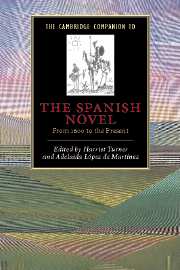Book contents
- Frontmatter
- 1 On the novel: mirror and text
- Part 1 Since Cervantes
- Part 2 The nineteenth century
- Part 3 The twentieth century
- 10 From the Generation of 1898 to the vanguard
- 11 The testimonial novel and the novel of memory
- 12 Questioning the text
- 13 Women and fiction in post-Franco Spain
- 14 Cultural alliances: film and literature in the socialist period, 1982–1995
- 15 The novel beyond modernity
- 16 Writing about writing
- Bibliography
- Index
- Series List
13 - Women and fiction in post-Franco Spain
from Part 3 - The twentieth century
Published online by Cambridge University Press: 28 May 2006
- Frontmatter
- 1 On the novel: mirror and text
- Part 1 Since Cervantes
- Part 2 The nineteenth century
- Part 3 The twentieth century
- 10 From the Generation of 1898 to the vanguard
- 11 The testimonial novel and the novel of memory
- 12 Questioning the text
- 13 Women and fiction in post-Franco Spain
- 14 Cultural alliances: film and literature in the socialist period, 1982–1995
- 15 The novel beyond modernity
- 16 Writing about writing
- Bibliography
- Index
- Series List
Summary
When the Franco dictatorship ended in 1975, the time was ripe for the revitalization of women's literature in Spain. Spain's transition to democracy led to a so-called boom in women's narrative, with the emergence of a new group of women writers who began to publish at that time: among them are Rosa Montero, Lourdes Ortiz, Soledad Púertolas, Marina Mayoral, Cristina Fernández Cubas, Carme Riera, and Esther Tusquets. Still others such as Carmen Martín Gaite, Ana María Moix, and Montserrat Roig, who had already published during Francoism, started to write more self-consciously experimental works in the late 1970s, thus departing from the predominantly neorealist aesthetic of their own and other women's works in the earlier decades of the post-war period. Without attributing homogeneous characteristics to this group of women based on strictly chronological or historical criteria, it would not be inaccurate to claim that the literary techniques and preoccupations of post-Franco women writers generally constitute a break from the previous generation of writers.
A brief overview of women’s social, political, and cultural history shouldserve to contextualize twentieth-century Spanish women’s literature and literaryhistory. In Spain, the women’s movement not only arrived late, incomparison to other Western societies, but was also slow to develop withinstrictly women-centered, feminist organizations.
- Type
- Chapter
- Information
- The Cambridge Companion to the Spanish NovelFrom 1600 to the Present, pp. 212 - 230Publisher: Cambridge University PressPrint publication year: 2003
- 2
- Cited by



